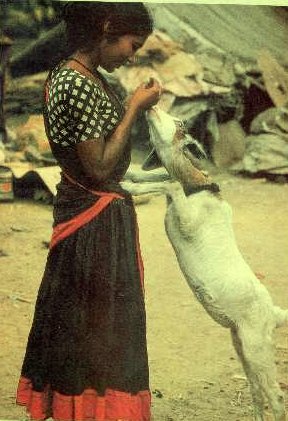

Home | Biodata | Biography | Photo Gallery | Publications | Tributes
Narikorava Studies

 |

Home | Biodata | Biography | Photo Gallery | Publications | Tributes Narikorava Studies |
 |

There is no distinct physical characteristic that identifies these people but their dress, language and lifestyle set them apart. The Narikorava women, called kurathis, wear coloured skirts, with pleats. They sport beads, shells and cowls around their necks and carry sling bags. The men who wear just loin clothes and turbans often stain their teeth black with copper sulphate and a paste made from acacia arabica.
Adept in the art of catching animals and birds, Narikoravas
can even trap a jackal, considered to be the most cunning of all animals. It is
this ability, which gives them their name Narikorava![]() the
jackal people. In order to catch a jackal, the man builds an enclosure made of
net, sits inside and mimics the howl of a jackal. When the hapless animal
approaches the net to investigate, he clubs it. To trap partridges, which are
much sought after for the pot, the Narikoravas use domesticated birds, which act
as decoys to catch the wild ones. This is the reason why they are also called
Kuruvikaran, or the birdmen. In fact, supplying game birds to town dwellers has
been one of their traditional occupations. With the implementation of the Wild
Life Protection Act, the Narikoravas had to change their livelihood and they
have consequently switched over to making beads and selling knick-knacks.
the
jackal people. In order to catch a jackal, the man builds an enclosure made of
net, sits inside and mimics the howl of a jackal. When the hapless animal
approaches the net to investigate, he clubs it. To trap partridges, which are
much sought after for the pot, the Narikoravas use domesticated birds, which act
as decoys to catch the wild ones. This is the reason why they are also called
Kuruvikaran, or the birdmen. In fact, supplying game birds to town dwellers has
been one of their traditional occupations. With the implementation of the Wild
Life Protection Act, the Narikoravas had to change their livelihood and they
have consequently switched over to making beads and selling knick-knacks.
In the earlier days they resisted any attempt to settle them in one place. If they are nomads, where are they originally from? Other than a short note by Edgar Thurston in 1905, these people have not received any scholarly attention. It was in the early seventies, Dr. Gift Siromoney of the Madras Christian College, with the help of the students in the Statistics Dept. of the College, conducted a series of research projects on the life of these people and published the results of his studies in the form of Monographs*. These projects have helped us to understand them better.
The language of the Narikoravas, Vagriboli, has traces of Marathi, Telugu and Tamil and has been classified as Indo-Aryan. It has no script. Dr. Gift Siromoney, as a part of his research project on the Narikoravas, brought out a primer to help learn this language through Tamil. The following booklets were also brought out by him: Thirukkural, St. Mark's Gospel and St. Luke's Gospel in Vagriboli
The medicinal plants
used, and the musical chants of the
Narikoravas were studied.
Psychological and IQ tests performed on Narikorava children showed that they
were more intelligent than the corresponding neighbouring village children.
From "The Narikoravas:Colourful Nomads of Tamil
Nadu"
Text:S.Theodore Baskeran
Pictures: John Isaac
Swagat, February,
1989
Publications
